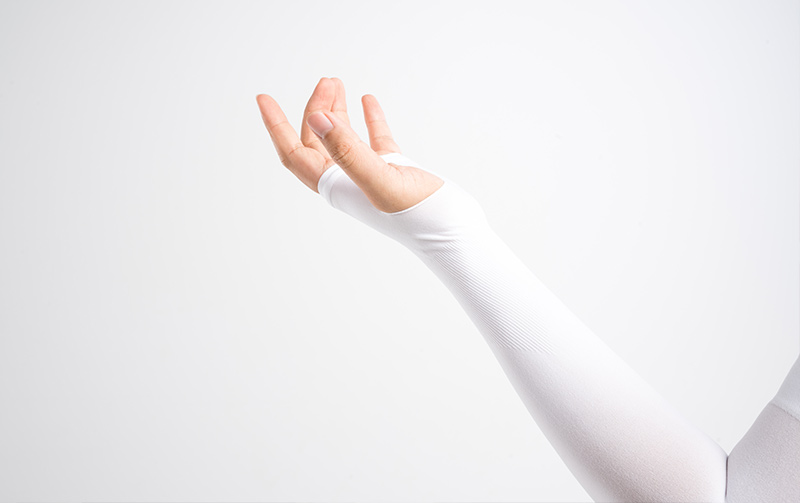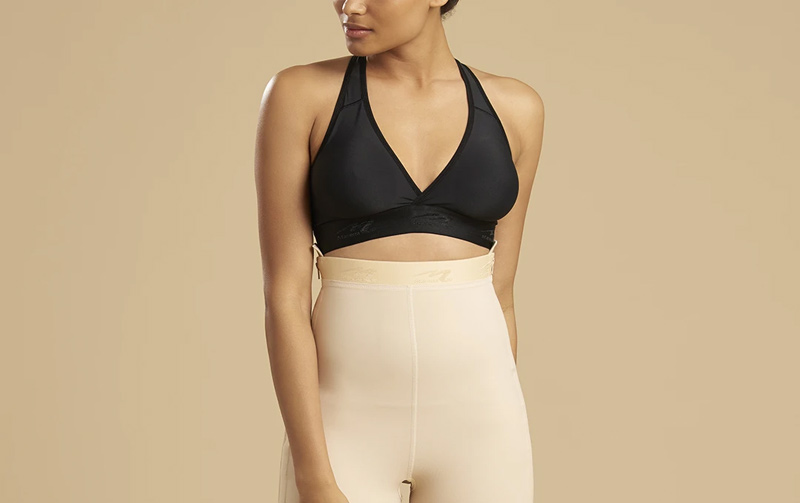Recovery Garments After Plastic Surgery
For patients undergoing breast surgery, liposuction, body lift, or any other body contouring procedure, the post operation plan includes wearing a postoperative surgery garment for a certain amount of time. The recommended type of garment and length of wear is specific to the procedure performed. It is important that the patient wears a breathable, comfortable and flexible fabric with the appropriate level of compression to promote healing and minimize swelling.
Good Recovery Garments Checklist
Promote healthy blood circulation
After any major surgery there is a small risk of developing blood cloths. It is important that recovery garments are not so tight that they prohibit blood floor to the tissues.
Reduce bulging or rippling in the treatment area
As tissues heal, ripples, bulges, or waves can develop within the tissue. Post operative recovery garments help to shrink wrap the tissues and prevent changes of tissue bulging or rippling. It is important that the garment be tight enough that it provides mild to moderate compression in the surgical area.
Improve and support mobility
Moving around is especially important after surgery. Movement helps to promote healing and a quicker recovery. Garments ideally should provide needed support and reduce discomfort with movement, therefore encouraging more activity in the immediate post-operative period.
Fits snug but not too tight
It is extremely important for a compression garment to fit the patient properly. The fit of the garment should be taut and snug, but not tight on the skin or cutting off circulation.
Washable and reusable
The garment should be washable so that it can be reused. Recovery garments may get stained from blood and drainage so it is important to be able to wash them from time to time.
Easy to put on and take off
Struggling to take off and put on recovery garments should never be an issue. Location of zippers or clasps should also be noted to avoid injuring incision sites and healing skin. Overall, the garment should completely cover the treated area and not leave any treated area exposed. Even though most of these types of garments are washable, these garments should be taken off when washing or showering. Any clothing worn over these garments should be soft and loose.
Types of post-operative recovery garments
Surgical bras
Surgical bras can be used for operations like breast augmentations, breast reconstruction, and mastectomies. The bras can either be in the form of a sleek sports bra or can be a more bulkier chest-level vest.

Compression vest
A compression vest is commonly used in gynecomastia surgery to help the body heal by promoting skin retracting, providing support, and controlling swelling. A compression vest can also be used in breast surgery procedures as an alternative to a surgical bra in some cases.

Compression arm sleeves
Compression arm sleeves look like a long sleeve that can extend from the wrist to the shoulder. Sleeves are more commonly used for procedures in the arm region to improve circulation.

Compression girdles
Compression girdles cover the area from the buttocks to the upper chest and are commonly used in tummy tuck and liposuction procedures.

Abdominal binder
An abdominal binder is a wide compression belt that encircles the abdomen and is mostly made from elastic with velcro or hook and loop closures.

Mid thigh girdles
Ideal for procedures in the buttocks, thigh, and abdominal regions, the mid thigh girdle extends from the thigh to the abdomen, just below the chest. The patient will place both legs through the girdle which gives the appearance of high waisted shorts.

Compression stockings
Compression stockings can be worn on procedures involving the outside leg region to improve the overall blood circulation and to prevent blood clots. These stockings, depending on the model, can end just above or below the knee.

Recovery Garment Instructions Based on Type of Plastic Surgery
Breast Surgery
breast augmentation, breast lift, and/or breast reduction
- It is recommended to wear a surgical bra with a hook and eye closure for about a week following the procedure.
- After a week, a cotton sports bra that has Velcro in the front can be worn to avoid stretching the arms along the back which can cause injury to the wounds.
- DO NOT use any underwire bra for 8 weeks following surgery.

Tummy Tuck
Full tummy tuck and mini-tummy tuck
- It is recommended to wear an abdominal binder, a liposuction compression garment, or an above-knee to chest garment depending on the area of liposuction.
- The garment should be worn for about 4 to 6 weeks in total. It is best to wear the garment for 2 to 3 weeks and then transition to wearing the garment 12 hours on and 12 hours off for another three weeks.

Arm Lift
- It is recommended to start wearing a sleeve compression garment once the drains have been removed.
- For optimal healing, a pressure type bandage like an ACE bandage or wrap can be worn for 2 to 3 days only and then a sleeve for post-surgical compression for 1 week.
- It is important to find a sleeve that contours well to the patient’s arms and is gentle enough on incisions.
- Swelling can build in the hands due to the compression. If the swelling is abnormal, contact your plastic surgeon to discuss switching compression garments for a better fit.

Thigh Lifts
- It is recommended to start wearing a sleeve compression garment once the drains have been removed.
- An above or below knee to chest garment is recommended with a transition to Spanx after 2 to 3 weeks. This is recommended because the above or below knee to chest garment will provide an even compression to the area and is gentle on incisions.
- Pressure garments should be worn first thing in the morning prior to placing the feet on the ground, worn continuously throughout the day, and removed just before bed.

Liposuction
- Elastic compression garment should be worn 24/7 for 6 weeks following the liposuction surgery. After 6 weeks, the patient should then wear the garment for an additional 6 months at night.
- This garment should only be removed to shower once a day. The patient is allowed to shower about 24 hours after surgery.
- Often times 2 garments are purchased so there is a fresh/clean garment to wear while the soiled garment is being washed.
- For men, some spanx shirts can be worn post surgery as an alternative to the elastic compression garment.
- Garment type and shape will depend on location of liposuction.
Gynecomastia Correction
- It is recommended that a compression vest is used to prevent the skin and tissue from healing the wrong way during recovery.
- The compression vest should be used daily for the first 4 weeks following surgery.

Chin Augmentation
- It is recommended that a compression garment or wrap be used to hold the chin area in place immediately following surgery and up to 1 to 3 weeks after surgery.
- A facial compression garment that has a strap to provide pressure and support to the chin area with the appropriate compression level will help to improve blood circulation and minimize swelling.

Butt Lift
- It is best to wear a garment that has a lighter buttock cut out to allow compression around the buttocks and to protect the treatment area.
- Butt lift garments should be able to unzip completely around the leg for easy removal when showering or using the restroom.
- It is recommended that this garment be worn for a total of about 3 to 6 weeks. The first 2 to 3 weeks, the patient should wear the compression garment 24/7.

Total Body Lift
- For a total body lift procedure, it is recommended to wear an elastic compression garment that covers the entire treatment area
- The elastic compression garment should be worn at all times for the first 4 to 6 weeks after surgery depending on the healing process. After 6 weeks, it can be worn for 12 hours per day for an additional 6 months for the best healing.
- It is recommended that the patient has 2 garments so there is a fresh/clean garment to wear while the soiled garment is being washed.
- Foam inserts can be placed in the compression garment for the first 6 weeks for better movement and comfort.
- It is also recommended to wear soft, loose clothing that is easy to take on and off over the garment.
